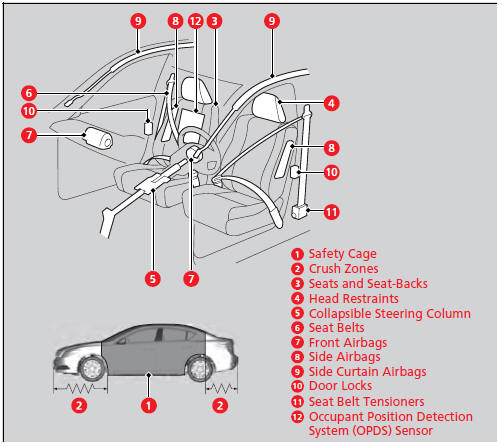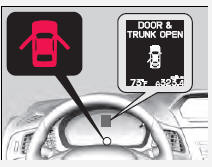Your Vehicle's Safety Features

The following checklist will help you take an active role in protecting yourself and your passengers.
Your Vehicle's Safety Features
Your vehicle is equipped with many features that work together to help protect you and your passengers during a crash. Some features do not require any action on your part. These include a strong steel framework that forms a safety cage around the passenger compartment, front and rear crush zones, a collapsible steering column, and tensioners that tighten the front seat belts in a sufficient crash. However, you and your passengers cannot take full advantage of these features unless you remain seated in the correct position and always wear your seat belts. In fact, some safety features can contribute to injuries if they are not used properly.
Safety Checklist
For the safety of you and your passengers, make a habit of checking these items each time before you drive. • After everyone has entered the vehicle, be sure all doors are closed and locked. Locking the doors helps prevent an occupant from being ejected and an outsider from unexpectedly opening a door.
• Adjust your seat to a position suitable for driving. Be sure the front seats are adjusted as far to the rear as possible while allowing the driver to control the vehicle. Sitting too close to a front airbag can result in serious or fatal injury in a crash.
• Adjust head restraints to the proper position. Head restraints are most effective when the center of the head restraint aligns with the center of your head. Taller persons should adjust their head restraint to the highest position.
• Always wear your seat belt, and make sure you wear it properly. Confirm that any passengers are properly belted as well.
• Protect children by using seat belts or child seats according to a child's age, height and weight.
Safety Checklist
If the door and trunk open indicator is on, a door and/or the trunk is not completely closed. Close all doors and the trunk tightly until the indicator goes off.

See also:
Parts and Fluids Used in Maintenance
The use of Acura genuine parts and fluids is recommended when maintaining and
servicing your vehicle. Acura genuine parts are manufactured according to the
same
high quality standards used in Acur ...
Headlight Bulbs
When replacing, use the following bulbs.
High beam headlight: 60 W (HB3)
Low beam headlight: 55 W (H11 for halogen bulb Type) ...
Housing Locations
The front airbags are housed in the center of the steering wheel for the
driver, and
in the dashboard for the front passenger. Both airbags are marked SRS AIRBAG.
Front Airbags (SRS)
Dual-Stage, ...
